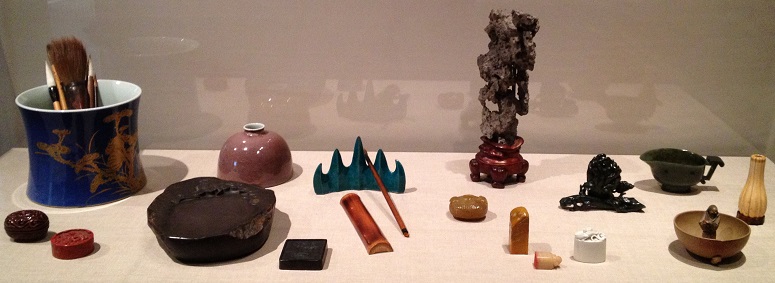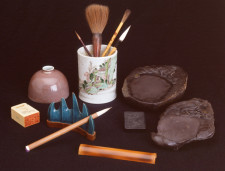Scholar’s Desk Checklist (as of 5-31-2012)

Unknown
Chinese, Ming dynasty on
Objects from a Chinese Scholar's Study, 17th c. CE - 20th c. CE
porcelain, wood, stone, pine soot, ivory, animal hair, bamboo, limestone, soapstone and nephrite
SBMA, Gifts of F. Bailey Vanderhoef, Jr., and others
1991.148...
RESEARCH PAPER
[Editor's Note: This paper provides an excellent overview, but note that various individual objects have rotated in and out of the display since the paper was written.]
The Chinese scholar elite, or literati, of the Ming dynasty (1368-1644) were arbiters of taste in literature, music, and all of the plastic arts. Although the conquering Qing dynasty attempted to restore orthodox traditions after the Ming dynasty fell; literati aesthetics remained influential and even now are relevant in contemporary Chinese art (useful for providing a transition to other objects in the gallery). Even though some of the objects in the SBMA scholar’s study exhibit are Qing or later, they can all be considered from the viewpoint of Ming aesthetics, which were grounded in studies of past traditions. (That Ming scholars collected and studied antiques provides another transition.)
Ming Scholars wrote about almost everything that can be observed and used, describing the ideal study or studio and its contents. Wen Zhengming (1450-1559) wrote in his treatise “On the Things of This World,” that scholars’ studies should “exude the aura of a refined recluse.” He described a study situated among trees, plants, and water containing a collection of antiquities, books and fine art, all reflecting the scholar’s spiritual values as well as his exquisite taste. In a list “playfully” made in 1629, the scholar Li Rihua ranked objects to be desired: First came the calligraphies, handwritings, and paintings of both past and present masters; next ancient bronze vessels, antique jades, ink stones, zithers, and swords; then picturesque rocks, gnarled pines, needlelike rushes, plum trees, and bamboo; then spices, teas, imported foods and treasures; and, finally, shiny white porcelain and mysteriously colored pottery, old and new. In such a paradise, a scholar might immerse himself in the ideas and interests of the ancients and be inspired to greatness.
Ming scholors believed that art should be expressive rather than forced and simple essential, plain, or implied rather than decorative. They held that “effortless excellence” was a higher order of creativity than craftsmanship, and they strove for spontaneous expression of the spirit. They also valued strange, interesting, or unexpected expressions of the essence of a thing, such as the irregular crazing of a glazed ceramic or a rock formed like a miniature mountain. To describe their preferences, they used the terms ya, meaning elegant, refined, and distinguished, and su, meaning vulgar, common, and unexceptional.
In the SBMA reinstallation are two Ming Dynasty inkstones, one with a leaf and animal design, and one with a dragon and cloud design. The inkstone along with brush, ink and paper are key elements supporting each of the Scholars Three Treasures (painting, poetry and calligraphy). The stone must have both a flat area for rubbing the ink stick and a well for the drop by drop addition of water. A decorative ceramic waterpot such as a fruit or animal with a hole for filling and a much smaller hole for dripping out of the water is used for adding water. The stone must be abrasive enough to hold the ink and smooth enough not to harm the brush. Above all, as the most visible object on the table, it must reflect the scholar’s good taste, which usually meant an elegant simple shape with distinctive color and markings in the stone. Carved inscriptions and seals often indicated ownership and wishes such as “May sons and grandsons use this forever” or poems such as “Treat me like jade; To be among gold or grain would insult me.” By grinding his own ink against the moistened stone, the scholar had complete control over texture, quality and value, or darkness, so that he could mix “the five colors of ink.”
The 19th century inkstick in the exhibit is similar to those used by scholars of earlier times. For blackness and durability pine soot is mixed with animal glue made by boiling bones and hides to bind the solid ink dust together and improve the ink’s adherence to the paper. The thick raw ink paste is then put into a wooden or copper mold, which impresses it with designs and shapes it. Some ancient recipes called for over a thousand different ingredients from egg white to crushed pearls. During the Ming period albums of ink stick designs were published, and by the late Ming many inksticks were made for presentation purposes. By the Qing dynasty, collecting inksticks had become popular. This inkstick does not appear to have been used and has a painted architectural design on one side and two characters on the other. The waterpot in the exhibit dates from the early Qing dynasty and has a Kangxi mark (1662-1772). The porcelain has a mottled grey and reddish purple glaze over incised medallions. The literati taste was for simplicity of form without excessive surface ornament and for attractive glazes which exhibit qu or interesting irregularity. An abundant supply of fresh clean water was important in the scholar’s studio. Water was needed for mixing ink, cleaning brushes, and brewing tea. The tasting of water was itself a form of delectation. Water was a metaphor for the ideal of dan (slight taste and light coloring), and the infinite changeability of its surface was an allegory for the artistic manifestations of the creative spirit. The assorted brushes of animal hair with bamboo and wooden handles date from the 20th century but are similar to brushes used in the Neolithic period. Various types of hair would be grouped in concentric conical rings with a void between inner and outer layers. The void acted as a reservoir to hold the ink. The brush could be custom designed to suit the individual. The head of a brush would be replaced as needed because of wear, and although some luxurious brush handles were made of porcelain, ivory, or jade, the most preferred material for handles was wood or bamboo.
The porcelain brushwasher with a small dragon in relief dates from the later Qing dynasty, in the 18th century. Ming scholars admired and collected porcelains with monochromatic glazes, particularly white, as exemplifying the ideal of dan. Note also the “Blanc de Chine” porcelain seal, Qing 18th c. and the pair of cups, Qing 19th c.
Brush holders and rests were also part of the scholars’ paraphernalia. These objects in the exhibit also date from the Qing dynasty. The use of ceramic brushrests dates back at least to the Tang dynasty. The mountain form is functional for holding and separating wet brushes being alternated during use and it relates to the significaant role that mountains play in Chinese thought and painting. In the late Ming period such brushrests often depicted the topographical features of individual locales. The turquoise and aubergine monochrome glazes of the two rests exhibited reflect literati taste whereas the painted designs in the underglaze of the porcelain brush holder might require a sensibility more in tune with the court.
While the literati held in highest esteem the inspired work of scholar-amateurs, particularly in painting and calligraphy, they valued and influenced the craftsmen who provided them with objects for their studios. Carving, in particular, did not lend itself to spontaneity; it demanded skill developed over many years and careful, patient and tedious execution. In the exhibit we can place in this category the Qing seal, brush holder, and the Ming vase carved out of ivory, and also the more recent (19th-20th c.) wrist rest of bamboo. Seals were used by the literati as signatures on original work and also as marks of ownership on collected work. Literati preference was for seals showing learning and taste, perhaps in emulation of bronze seals from the Han dynasty. Seal carving in soft soapstone became a branch of literati art, but ivory, jade and bamboo were materials best left to professionals. Bamboo was a material particularly favored because it was a symbol of the literati; the graceful bamboo was the antithesis of vulgarity as was the scholar who painted it. The carver could use the rock-hard, almost-solid underground bamboo laterals or he could carve the stalks leaving portions of green skin which would age to golden yellow contrasting to brown where the skin was removed. The wrist rest was one of the many new accoutrements that appeared in the Ming dynasty and was used to support the wrist while doing fine work with the brush.
Other objects found in the scholar’s study included all manner of small boxes and containers for such necessaries as aromatics, tea, wine, flowers and plants. Scholars also required scroll weights, fans, censors or incense burners, books, zithers, paperweights and “toys” such as the chimera in the exhibit. And of course, they displayed their finest paintings and antiques in a carefully arranged manner. The exhibition helps us to imagine the Chinese scholar’s study as a retreat from the world and an expression of taste. There the scholar could become connected to the past and to his moral and creative self.
Prepared for the Santa Barbara Museum of Art Docent Council by Ellen Lawson, October, 1995.
Edited and typed for the web by Jean McKibben Smith

SBMA CURATORIAL LABELS
One group of objects highly valued by the Chinese scholar-official consists of items commonly found in his study, a place where a man came to read books, compose writings, practice calligraphy or painting, or simply contemplate. Foremost among these items are writing implements - paper, ink, brushes, inkstone (known as the "four treasures of the study"), and related paraphernalia. These personal objects reflect the aesthetic of their owner who, in the scholar's tradition, cultivated a taste for simplicity, elegance and refinement as well as an appreciation for objects made of rare materials and fine craftsmanship.
- Asian Gallery, 2012
